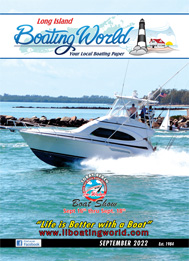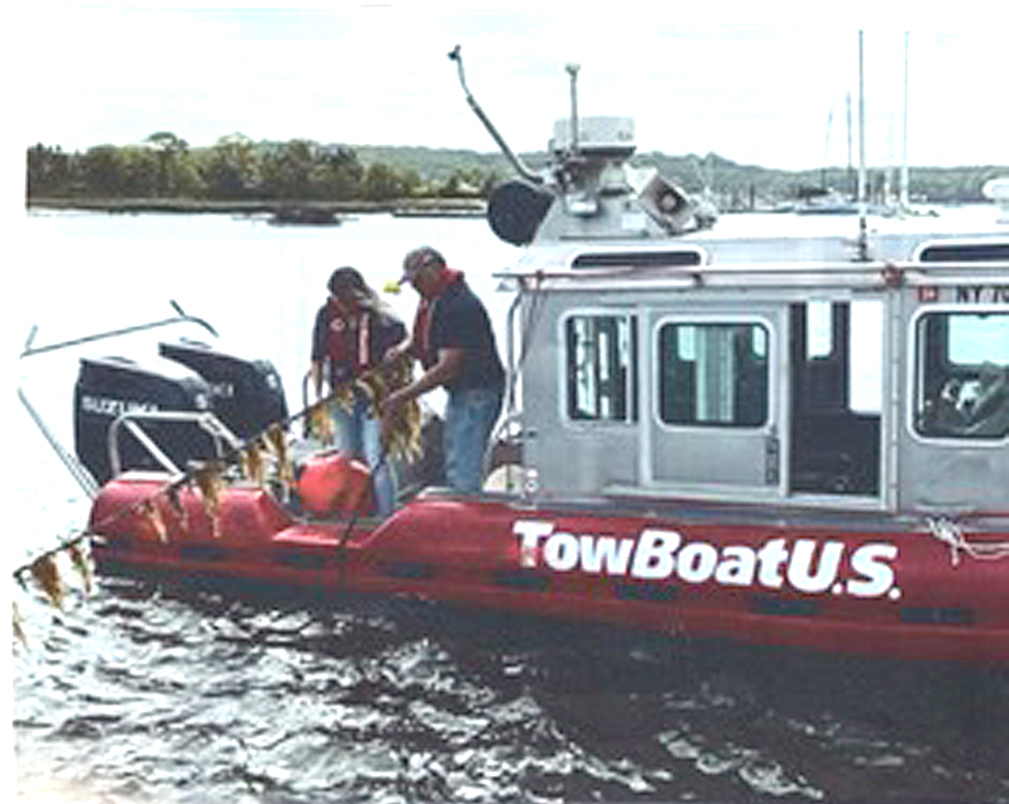
What do you call a man with serious interests in growing kelp, cleaning up beaches and the surrounding waters and partnering with Cornell Cooperative Extension, Stony Brook University, Adelphi University, the Town of Oyster Bay, Lazy Point Farms and Friends of the Bay? You’d call him Captain Mitch Kramer, owner of TowBoatUS Oyster Bay. His company has a long-term contract with BOATUS. Not a franchise, Captain Kramer’s company hires the captains who answer boaters’ calls for help and they are paid by his company.
BOATUS was started in 1966 by Richard Schwartz and sold by Mr. Schwartz in 2007 to Berkshire Hathaway-owned subsidiary National Indemnity Co., a commercial auto and general liability insurance company. In an attempt to stimulate growth of membership, BOATUS ownership was transferred to GEICO recently – another Berkshire Hathaway company. BOATUS hopes to double or triple its membership with its new connection in Washington. Currently the largest recreational boating advocate, its membership is in the 600,000 plus area.

How did BOATUS get started? A trip out on the Chesapeake Bay in l965 on a friend’s new boat surprised Schwartz when the Coast Guard stopped and boarded the boat just after they left the dock. The friend’s new boat didn’t comply with Coast Guard standards for engine ventilation. His friend was ticketed for this engine compartment ventilation system problem.
A Yale Law graduate, Schwartz couldn’t believe the boat’s manufacturer had no liability to meet safety standards and the Coast Guard had no jurisdiction over the manufacturer, leaving the boat buyers responsible for their boats after purchasing them. As a lawyer he saw the need for congressional legislation to bring the needs of boaters to meet safety standards the Coast Guard thought were part of a safe boat together with the boats manufacturers were selling.
Getting legislation passed that put the responsibility for safe boats on the manufacturers is not the only benefit of BOATUS. They provide boater safety education, discounts on fuel and boat slips, how-to videos, BOATUS Magazine, Seaworthy Newsletter and towing plans. As the AAA of the waterways, the towing plans have been compared to the help car owners get on the highways.
Annual dues of $24 and costs for towing plans will remain the same. Most of the calls for assistance come from boaters with unknown engine problems and the average size response boat is 26 feet. Some of the boat brands commonly used to assist boaters are Boston Whalers, Zodiac, Silver Ships and Shamrock.
Doing everything marine from towing to salvage and everything in between is how Captain Kramer describes the work of his company. TowBoatUS Oyster Bay. As an experienced diver, he heard the call that the Kandi Won, a 34 foot Silverton with 27 passengers aboard, some of them children, had capsized as it was leaving the Oyster Bay area of the Long Island Sound in 2012 where hundreds of boats gather annually for the July 4th Fireworks Display. All the boats left close to the same time just as a predicted storm started. Captain Kramer arrived, saw the overturned, now starting to sink, Kandi Won, put his mask and fins on, grabbed the air hose from his boat and jumped in, still fully dressed. He made a number of attempts to find the children but the boat was half submerged, upside down and battered by the waves of other homebound boats. He knew there were children in the boat but couldn’t get past canvas and debris to get the cabin door open. The next day divers went down 60 feet to recover the bodies of the three children who had died. Captain Kramer was later awarded a Meritorious Service Award for his rescue help. “I knew there were children inside,” he said, “Your adrenalin is definitely pumping.”
I asked Captain Kramer what he saw himself doing as his life’s work when he was a boy in school. He remembers a teacher telling him his hobbies of boating and fishing were not careers and that he should choose something realistic. He could not see himself in a 9 to 5 job and never really had a plan, but after college graduation, he started his marine business to keep busy until he decided what his future would be. Now, thirty years later, it still works for him and he is aware that he’s more fortunate than most.
Captain Kramer was born and raised in the Oyster Bay-East Norwich area by a family that provided him with a strong work ethic. Some of his time off from school in the summers was spent boating but he also did underwater boat cleaning, landscaping and drove a launch for a yacht club. His parents, he said, taught him at a young age the importance of working hard for the things he wanted.
In his multiple trips through the waters of Long Island Sound Captain Kramer has seen big changes in the condition of the water as nitrogen and carbon dioxide have fueled the growth of microscopic algae, lowering the oxygen levels in coastal waters. He saw seaweed farming as having the potential to improve the water quality. Dr. Christopher Gobler, co-director of the Clean Water Technology Center at Stony Brook University spoke recently about the issues of climate change and pollution and how growing sugar kelp would eliminate a lot of the nitrogen and carbon dioxide, so much that it might make the expensive new septic systems planned for Long Island homeowners unnecessary. The improved water quality from growing kelp would also slow the growth of microscopic algae. Improved water quality also provides inviting habitat for fish
Seaweed farming began in Japan in the 1600s in Tokyo Bay where the fishermen would throw bamboo branches into shallow, muddy water where the spores of the seaweed would collect and they would move the branches to a river estuary. In the 1940s they doubled their production by attaching synthetic nets to bamboo poles. Kelp is used as a thickener or stabilizer in ice cream and is listed in Amazon’s advertising as a salad ingredient.
One of the early growers of sugar kelp, Dr. Charles Yarish, harvested kelp in the 1980s that was 39 feet long. The growing season was longer then because the water was colder. The size of more recently grown kelp from that area averages 26 feet.
Captain Kramer has become part of the Lazy Point Farm organization, a group that believes in growing sugar kelp and has partnered with Stony Brook University School of Marine and Atmospheric Sciences. Captain Kramer sees kelp farming as a way to improve water quality. As a winter crop it will provide oyster farmers with a year-round income. On the plus side, those who are trying to grow kelp in shallow water are finding they can make it work. It’s happening in Moriches Bay and Great South Bay. The bonus for oyster farmers is that space allocated to oysters in the summer can be used to grow kelp in the winter. A second bonus is that in shallow water growing kelp doesn’t require the expense of a boat. This is truly a low barrier to entry business.
Captain Kramer’s other interest is in Friends of the Bay, a group that not only goes to beaches and cleans them up, but also goes out in their workboat and cleans up debris from the water.
